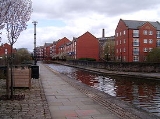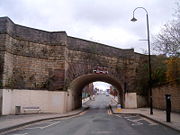
Store Street Aqueduct
Encyclopedia
The Store Street Aqueduct in central Manchester
, England
was built in 1798 by Benjamin Outram
on the Ashton Canal
. A Grade II* listed building it is built on a skew of 45 degrees across Store Street, and is believed to be the first major aqueduct of its kind in Great Britain
and the oldest still in use today.
 Generally, where a canal (or later a railway) crossed a road, or vice versa, the road would be diverted to cross at right angles. It had not always been acceptable but attempts to build masonry arch bridge
Generally, where a canal (or later a railway) crossed a road, or vice versa, the road would be diverted to cross at right angles. It had not always been acceptable but attempts to build masonry arch bridge
s at an angle, or "skew" of greater than about 15 degrees, had proved unsatisfactory.
The method up to that time had been to build the voussoir
arch with the stone course work parallel to the abutment
s. This transmitted the load outward from the crown in a straight line to the foundations, parallel to the faces of the arch. If a skew was attempted, it threw the lines of force outside the abutments, leading to weakness in the structure.
William Chapman
had partially solved the problem in 1787 when building bridges for the Kildare Canal, the first being the Finlay Bridge near Naas
. The Kildare was part of the Grand Canal Company
, for William Jessop
had been the engineer. Jessop would no doubt have discussed it with Outram, his partner, and he experimented with the idea on the Rochdale Canal
. Examples are Gorrell's Lane and March Barn road bridges, though it is possible that they were built later.
The method used was to build timber falsework parallel to the proposed arches. Planks were laid on the falsework parallel to the abutments. The position of the courses at the crown were marked out, then those across the remainder of the arch.
Although the aqueduct still exists, and is structurally sound, years of neglect led to water leakage through the joints, and the spiral construction can no longer be seen, the surface of the intrados having been rendered.
Later railway engineers improved on the system, producing what became known as helicoidal construction that became the norm in English skew bridge
building. An exact solution to the problem was determined in the form of the French, or orthogonal, design. However this was complicated and expensive to build.
Manchester
Manchester is a city and metropolitan borough in Greater Manchester, England. According to the Office for National Statistics, the 2010 mid-year population estimate for Manchester was 498,800. Manchester lies within one of the UK's largest metropolitan areas, the metropolitan county of Greater...
, England
England
England is a country that is part of the United Kingdom. It shares land borders with Scotland to the north and Wales to the west; the Irish Sea is to the north west, the Celtic Sea to the south west, with the North Sea to the east and the English Channel to the south separating it from continental...
was built in 1798 by Benjamin Outram
Benjamin Outram
Benjamin Outram was an English civil engineer, surveyor and industrialist. He was a pioneer in the building of canals and tramways.-Personal life:...
on the Ashton Canal
Ashton Canal
The Ashton Canal is a canal built in Greater Manchester in North West England.-Route:The Ashton leaves the Rochdale Canal at Ducie St. Junction in central Manchester, and climbs for through 18 locks, passing through Ancoats, Holt Town, Bradford-with-Beswick, Clayton, Openshaw, Droylsden,...
. A Grade II* listed building it is built on a skew of 45 degrees across Store Street, and is believed to be the first major aqueduct of its kind in Great Britain
Great Britain
Great Britain or Britain is an island situated to the northwest of Continental Europe. It is the ninth largest island in the world, and the largest European island, as well as the largest of the British Isles...
and the oldest still in use today.

Arch bridge
An arch bridge is a bridge with abutments at each end shaped as a curved arch. Arch bridges work by transferring the weight of the bridge and its loads partially into a horizontal thrust restrained by the abutments at either side...
s at an angle, or "skew" of greater than about 15 degrees, had proved unsatisfactory.
The method up to that time had been to build the voussoir
Voussoir
A voussoir is a wedge-shaped element, typically a stone, used in building an arch or vault.Although each unit in an arch or vault is a voussoir, two units are of distinct functional importance: the keystone and the springer. The keystone is the center stone or masonry unit at the apex of an arch. A...
arch with the stone course work parallel to the abutment
Abutment
An abutment is, generally, the point where two structures or objects meet. This word comes from the verb abut, which means adjoin or having common boundary. An abutment is an engineering term that describes a structure located at the ends of a bridge, where the bridge slab adjoins the approaching...
s. This transmitted the load outward from the crown in a straight line to the foundations, parallel to the faces of the arch. If a skew was attempted, it threw the lines of force outside the abutments, leading to weakness in the structure.
William Chapman
William Chapman (engineer)
William Chapman was an English engineer. Born in Whitby, he worked on the construction of the Old and Humber docks in Hull, as well as many drainage and canal projects. He is credited with the invention of the bogie and articulation for rail vehicles.-Personal life:William Chapman was born on 7...
had partially solved the problem in 1787 when building bridges for the Kildare Canal, the first being the Finlay Bridge near Naas
Naas
Naas is the county town of County Kildare in Ireland. With a population of just over twenty thousand, it is also the largest town in the county. Naas is a major commuter suburb, with many people residing there and working in Dublin...
. The Kildare was part of the Grand Canal Company
Grand Canal of Ireland
The Grand Canal is the southernmost of a pair of canals that connect Dublin, in the east of Ireland, with the River Shannon in the west,via Tullamore and a number of other villages and towns, the two canals nearly encircling Dublin's inner city. Its sister canal on the Northside of Dublin is the...
, for William Jessop
William Jessop
William Jessop was an English civil engineer, best known for his work on canals, harbours and early railways in the late 18th and early 19th centuries.-Early life:...
had been the engineer. Jessop would no doubt have discussed it with Outram, his partner, and he experimented with the idea on the Rochdale Canal
Rochdale Canal
The Rochdale Canal is a navigable "broad" canal in northern England, part of the connected system of the canals of Great Britain. The "Rochdale" in its name refers to the town of Rochdale, Greater Manchester, through which the canal passes....
. Examples are Gorrell's Lane and March Barn road bridges, though it is possible that they were built later.
The method used was to build timber falsework parallel to the proposed arches. Planks were laid on the falsework parallel to the abutments. The position of the courses at the crown were marked out, then those across the remainder of the arch.
Although the aqueduct still exists, and is structurally sound, years of neglect led to water leakage through the joints, and the spiral construction can no longer be seen, the surface of the intrados having been rendered.
Later railway engineers improved on the system, producing what became known as helicoidal construction that became the norm in English skew bridge
Skew arch
A skew arch is a method of construction that enables an arch bridge to span an obstacle at some angle other than a right angle. This results in the faces of the arch not being perpendicular to its abutments and its plan view being a parallelogram, rather than the rectangle that is the plan view of...
building. An exact solution to the problem was determined in the form of the French, or orthogonal, design. However this was complicated and expensive to build.
See also
- List of canal aqueducts in the United Kingdom
- Grade II* listed buildings in Greater Manchester
- Skew archSkew archA skew arch is a method of construction that enables an arch bridge to span an obstacle at some angle other than a right angle. This results in the faces of the arch not being perpendicular to its abutments and its plan view being a parallelogram, rather than the rectangle that is the plan view of...

